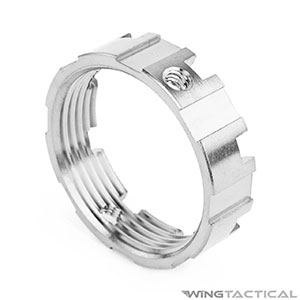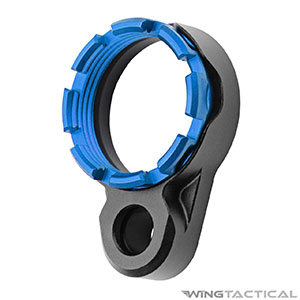The castle nut and end plate are two essential parts of an AR-15. They are situated on the receiver's end and are necessary for the proper and reliable performance of your AR platform rifle or pistol.

Castle Nuts and End Plates: Essential Components of an AR
Castellated nuts, also known as castle nuts are used in various items. They have notches on one end that appear similar to a castle's battlements, which is why they are called castle nuts. They are used to lock the nut in place to remain in its position and resist vibrations.
There are many things that AR-15 owners disagree on, and one of the biggest debates in the AR-15 community is whether you should or should not stake your end plates into your castle nut. Some say staking is essential to ensure the AR-15 castle nut stays tight, whereas some say that staking is permanent and doesn't allow you to change your buffer tube or endplates easily.
The truth is that staking is a good habit, especially on service or competition rifles that are used frequently. All Mil-Spec AR-15s have staked castle nuts. However, staking isn't necessary if you only occasionally use your rifle for shooting at the range or hunting.

AR-15 Castle Nuts
On AR-15s, a castle nut is used to join the buffer tube to the receiver. The castle nut keeps the buffer tube in place and resists the vibrations as the bolt moves back under tension from the buffer spring.

End Plates
The end plate is placed on the back of the receiver, keeping the rear takedown pin detent and spring in place, allowing your AR to function correctly. Moreover, the end plate also protects the rear of the lower receiver.
Explore AR Customization with Wing Tactical
Castle nuts and end plates are two potential customization avenues for your rifle. And, if you’re looking to create a unique custom build, there’s no better parts source than Wing Tactical. We partner with top manufacturers to offer the best of the best components in today’s small arms market.
If you need help with a project, would like assistance finding a product, or simply want to talk through your next build, reach out to our dedicated customer service team for support anytime.
Frequently Asked Questions
Why use aftermarket castle nut and end plate setups?
Many manufacturers make aftermarket castle nuts and end plates for AR-15s. These parts have many features that make them better than standard AR-15 castle nuts. Companies like PWS make a ratchet lock castle nut and end plate system, which allows you to have the stability and solid fit of a staked castle nut and ease of removal of a non-staked castle nut. Such setups can be great for competition-shooting rifles.
Some aftermarket endplates also have QD sling slots, or loops, which are great for AR pistols, which don't have a stock. These endplates allow shooters to add a sling to their AR pistol for carrying or to create forward tension while shooting.
Is it easy to replace an end plate?
Replacing a castle nut and end plate is simple: all you have to do is remove the buffer and spring from the buffer tube, remove the stock, and remove the buffer tube. Remove the existing end plate and castle nut and replace them.
If you stake your end plate into your castle nut, complete this step before sliding the buffer assembly back into the tube and the stock over the buffer tube. Finish staking, then reassemble the stock.
What is the best tool to stake a castle nut?
You’ll need vice grips, a hammer, and a center punch to stake an end plate into a castle nut. A round or square tip center punch will work for staking.
Can you reuse castle nuts?
You can certainly reuse castle nuts, but if you’re already replacing your end plate, replacing the castle nut is convenient and offers additional reassurance that your receiver and stock are securely connected.






